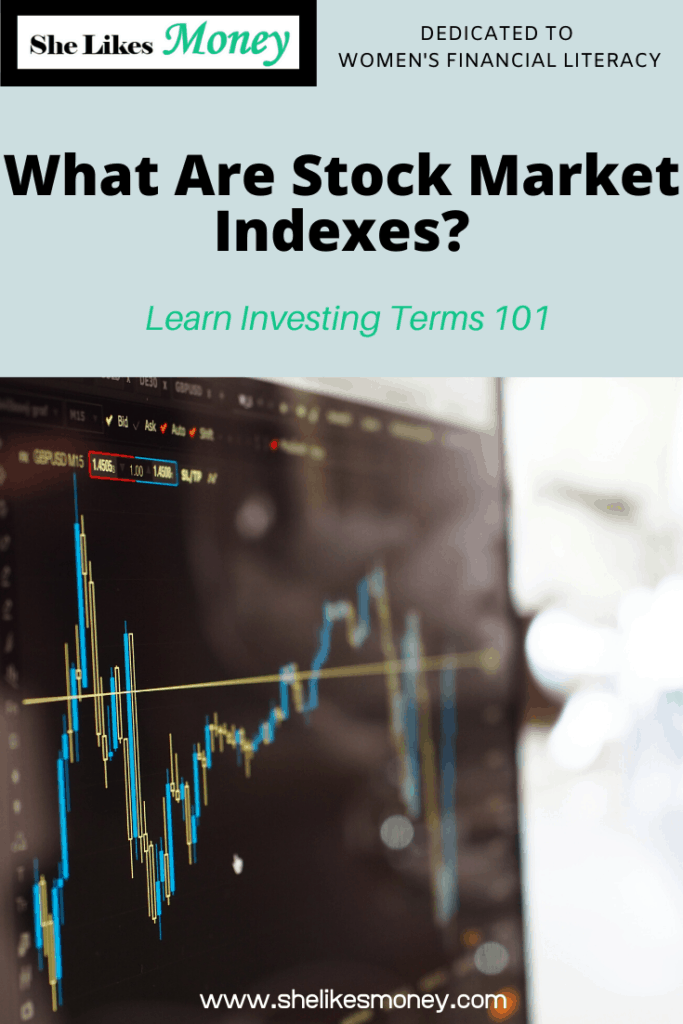Stock Market Indexes IRL: “The Dow dropped 300 points. Crazy right?” – Overhead dinner/work/drinks conversations
U.S. stock market indexes – like, ahem, the Dow Jones – come up all the time in adulting life. If you zone out when that happens…well it’s time to finally understand what they mean. Learn what stock market indexes are, why the news constantly talks about certain ones, and why you should bother knowing about them.
Stock Market Index Basics
Indexes are handy ways for us to see how a select group of assets is performing at any given time. There are over 5,000 indexes of the U.S. equity market. Think of an index as a pretend portfolio made of certain financial assets.
The key word is pretend. You cannot buy a share of the S&P 500 or Dow Jones. You can buy a share of an ETF or mutual fund that mimics the S&P 500 or Dow Jones, however. More info below on what the heck that actually means.
An index’s value changes when the prices of the assets it tracks change. Indexes use different metrics to assess the index’s value. Market-capitalization weighted, also called value-weighted, is the most common. Some are price-weighted or unweighted.
Think of weighting as a vote. The more votes someone has, the greater impact they have. Market capitalization weighting means that companies with bigger market caps matter most. Price weighting means stocks with higher prices matter more. Unweighted means every asset in the index matters the same.
To make the index numbers easily said in one breath, the index managers use a thing called divisors to convert the averages calculated into smaller numbers. All you really need to know is that when talking about index funds, their value and day-to-day movement are reported as points, not dollars. Each index has a different point-to-dollar ratio.
The Big Three U.S. Index Funds
If you’re going to learn about U.S. index funds, you should know the three most mentioned by news media and financiers: the S&P 500, the Dow Jones Industrial Average, and the NASDAQ.
Time for introductions.
S&P 500 (ticker: SPX: INDEX)
If the S&P 500 were a closet, it would be filled with 500 beautiful, designer pieces. (Brb, just drooled dreaming about the shoe options.)
S&P 500 is a market-capitalization-weighted index of – you guessed it – the 500 largest U.S. publicly-traded stocks. (Largest is decided by market capitalization.) The weighting means that when the largest companies’ stock prices move, the S&P 500 changes more dramatically than when the smaller companies’ stock prices move.
Why it’s important
The movement of the S&P 500 provides a snapshot view of the performance of the biggest companies in the U.S. It reflects, simplistically, the U.S. economy’s performance.
What it means for you
Investing in an ETF or mutual fund that tracks the S&P 500 gives you exposure to the biggest hitters in the U.S. economy while providing diversification across different industries. Large-cap companies are thought of as safer, less volatile equity investments. The reason people like it? Over a long-term investing period, the S&P 500 has an attractive return on your money.
The risk
If the largest companies in the U.S. stock market have an overvalued stock price, it could majorly inflate the index (thanks to the weighting by market capitalization). And overvaluation doesn’t usually end well. (Think sharp price drops as people sell off at highs.)
Note: this risk applies not only to the S&P 500, but any market capitalization-weighted index.
Dow Jones Industrial Average (ticker: DJI)
The Dow Jones Industrial Average (DJIA) is the capsule wardrobe of stock indexes. It’s made of 30 blue-chip (aka reliable, consistent revenue-generating) companies that trade on the New York Stock Exchange and NASDAQ.
The idea is that the companies in the Dow Jones reflect the broader U.S. economy.
It is price-weighted, meaning the companies with higher stock prices matter more in calculating the index’s value. The stocks in the DJIA are chosen subjectively based on their viewed impact and relevance in the U.S. economy, among other factors.
Why it’s important
The Dow Jones is commonly used across the world as a measuring stick of the U.S. stock market’s performance. These are influential U.S. companies that have been around a long time and consistently churn dollars. If you read any news, financial or otherwise, they’ll probably mention when the Dow Jones has a good or bad day.
What it means for you
Capsule wardrobes = no big fashion risks. Same with the DJIA. It doesn’t provide exposure to growth stocks, which are more volatile. That does mean missing out on potentially bigger returns but also could keep you from losing big money.
The risk
The DJIA is made up of mostly multinational U.S. companies, which means that current news headlines like trade wars, tariffs, and tricky U.S. international relations could negatively impact the Dow’s performance.
NASDAQ Composite Index
Do you have a friend that only wears one brand of clothing? (Or maybe you are that friend?) Well, meet your soul sister the NASDAQ Composite Index.
The NASDAQ is both a stock-exchange and an index. The index only represents one brand: the over 3,300 stocks that trade on the NASDAQ stock exchange. Like the S&P 500, the NASDAQ is a market-capitalization-weighted index, so movement in the stock prices of the bigger companies impact the index more.
What’s unique about the NASDAQ: It contains other types of securities besides regular company stocks, like REITs (real estate investment trusts), and provides exposure to non-U.S. companies. The NASDAQ exchange is also home to many of the world’s largest tech stocks like Apple and Microsoft.
Why it’s Important
The NASDAQ index provides exposure to a ton more securities than the S&P or DJIA. It also provides international exposure and includes several different types of securities, not just the common stock of companies.
What it means for you
The diverse type of securities, countries, and the sheer number of securities the NASDAQ index covers means better diversification for you. It may all be the same NASDAQ brand, but that doesn’t mean it’s not a colorful selection.
The risk
The NASDAQ Composite Index only provides exposure to stocks that trade on the NASDAQ exchange. Key players missing from its ranks are companies like Warren Buffet’s Berkshire Hathaway, China’s Alibaba, Wal-Mart, and major banks JPMorgan Chase and Bank of America.
The NASDAQ 100 Index vs NASDAQ Composite Index
NASDAQ makes things a little confusing by naming all its index children after the exchange. You might have heard about its other index offspring, the NASDAQ-100.
It’s an index that tracks the 100 largest non-finance companies that trade on the NASDAQ, both domestic and internationally based. You can see the full list here.
When the tech sector is doing great, the NASDAQ-100 also does great. If you want one-stop exposure to all the major tech stocks, then an ETF that tracks the NASDAQ-100 provides that on a platter.
The risk
Because the NASDAQ-100 Index is market-capitalization weighted like its Composite Index big brother, the bigger companies hold more power in the index. And because it’s only 100 companies, that means a change in Apple or Amazon’s stock price – the two largest companies in the index – can make a big wave in the index’s performance.
Another risk is the lack of equal exposure to other industries. The NASDAQ-100 leans heavily towards tech companies. The top five companies in the index – Apple, Microsoft, Amazon, Facebook, and Alphabet – account for over 40% of the index. This is because these companies all have very large market capitalizations. If government regulations were to impact these tech company’s business models, the index could plummet.
Other Common U.S. Stock Market Indexes
There are over 5,000 indexes in the U.S. alone. Here are some additional large-cap, mid-cap, and small-cap indexes you’ll often hear quoted in the news and fastidiously tracked by investment managers.
The Wilshire 5000 (ticker: TMWX or W5000)
The Wilshire 5000 is a market capitalization-weighted index that tracks 3,818 companies, all headquartered in the U.S., have stock listed and traded on U.S. exchanges, and have widely available pricing information.
Because of its broad inclusion and size, the Wilshire 5000 is thought of as a benchmark for the entire U.S. stock market.
Originally the index tracked 5,000 companies, hence the name. But the Wilshire 5000 hasn’t tracked 5,000 companies since December 29, 2005.
Here’s the link to all the members of the Wilshire 5000. You can also read up on its sector breakdown and performance here.
Besides the Wilshire 5000, there is also the Wilshire 4500, which tracks the same stocks the Wilshire 5000 does but excludes the stocks tracked by the S&P 500 (aka the really big companies). It’s considered a useful performance benchmark for small-cap and mid-cap funds.
Russell 3000 (ticker: RUA)
The Russell 3000 tracks 3,000 U.S.-traded stocks, which is about 98% of all U.S. incorporated equities. Like the Wilshire 5000, it covers a pretty good chunk of the U.S. stock market. It’s considered a good benchmark of the overall performance of the U.S. equity market.
The Russell 3000 is another market capitalization-weighted index, so the bigger companies are what really move the index most of the time. Every year at the end of June, the Financial Times Stock Exchange Group Russell (FTSE Russell for short) does a rebalancing of the exchange. This means it analyzes the stocks the index tracks and reorders their weight in the index based on their updated market capitalization.
The Russell 3000 tracks more stocks than the S&P 500, but they end up performing similarly. (You can compare their performances here.) Because both are market capitalization-weighted, the bigger companies pretty much determine how the index performs.
Russell 2000 & 1000 (ticker: RUT & RUI)
Like their big sibling the Russell 3000, the Russell 2000 and Russell 1000 are indexes operated by FTSE Russell and are market-capitalization weighted.
The Russell 2000 tracks the bottom two-thirds of the Russell 3000 index, meaning it mainly tracks mid-cap and small-cap U.S. stocks.
On the other hand, the Russell 1000 tracks the top third of the Russell 3000, which are all large-cap U.S. stocks.
Basically, the Russell 2000 and Russell 1000 split the duties of the Russell 3000, dividing the large-cap and mid-to-small-cap companies.
RECAP
Indexes are pretend portfolios of securities. You can’t buy a piece of them, but you can buy an ETF, mutual fund, or another investment vehicle that mimics their performance.
There are over 5,000 stock indexes in the U.S. The three most followed are the S&P 500, the Dow Jones Industrial Average (DJIA) and the NASDAQ Composite.
S&P 500: The fashionista’s dream closet. Tracks the 500 largest companies in the U.S. Market-capitalization weighted.
Dow Jones: The capsule wardrobe. Tracks 30 blue-chip companies in the U.S. Price-weighted.
NASDAQ Composite: The one-brand fan’s closet. Tracks the over 3,300 domestic and international securities traded on the NASDAQ stock exchange. Not to be confused with NASDAQ-100, which tracks the 100 biggest non-financial companies that trade on the NASDAQ exchange. Both are market-capitalization-weighted.
Investing in mutual funds or ETFs that track stock market index funds is one of the easiest and most accessible ways to start investing your money. It’s important to know what’s in the closet of any index-tracking fund you invest in.




